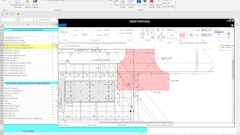
In the U.S., employers and employees spend more than $100 billion annually on back issues resulting from on-the-job strain and injuries, and lower back pain is the second leading cause of worker absenteeism after the common cold. Given the amount of heavy lifting done on construction sites, back problems for workers have always been a major concern.
Safety risks can be especially challenging during last-mile materials transport and confined space handling. Forklifts, cranes, and other tools that are specifically designed to move heavy materials may not be usable in these environments, meaning workers will use any means necessary to get the required materials to the worksite. Often this involves carrying loads that are far above the maximum lift-weight that OSHA guidelines suggest (OSHA recommends two or more people lift weights heavier than 50 pounds).
To help construction workers avoid lifting injuries and reduce daily strain, the industry needs more flexible tools. Powered, full-body, robotic exoskeletons, such as the Sarcos Guardian XO exoskeleton, is one example. These robots add mobility, flexibility, and strength to an operator, and can easily be used in environments where forklifts and other heavy lifting gear cannot go.
Most importantly, these wearable robots reduce the load on workers, which can limit injuries. Also, because they act as strength multipliers, one person can perform tasks that might otherwise take a small team to accomplish – no small feat, particularly in the age of COVID-19.
Robotic Exoskeleton Benefits
To be useful, wearable robots must be engineered to integrate seamlessly into a construction site. The tool must work in tight spaces and unstructured environments, and workers should be able to easily leverage the exoskeleton’s power and assistance. The goal is for them to simply do their jobs while the robot augments their capabilities.
Like human joints, the exoskeleton should provide freedom of movement, allowing workers to lift, bend, and maneuver in natural ways. Embedded sensors are ideal because they continuously measure the operator’s movements and adjust the robot accordingly, allowing the robot to perform in complete harmony with the operator.
[VIDEO] Ford’s Using Exoskeletons to Reduce Line-Worker Shoulder Injuries
A hands-free feature allows workers to lock the suit’s arms and complete dexterous tasks that require human hands, while still holding the heavy load. Operators can stop, take their hands out, and do fine alignment or tool work. This functionality can be quite useful in many situations, such as attaching sheetrock. The robot holds the heavy piece while the worker uses a drill to secure it. In this way, the robot can enable one worker to perform a task that might otherwise need a team.
A well-designed exoskeleton transfers its weight, as well as the weight of the payload, to the ground, eliminating strain on the operator. Powered exoskeletons can sense the payload weight and compensate for it automatically, reducing the weight workers feel while lifting. For example, carrying 200 pounds can feel like lifting a small ten-pound backpack.
Safety
Putting this technology to work on a construction site can translate into increased worker safety and productivity. Powered exoskeletons enable increased strength and support a smoother lifting motion, helping workers move heavy objects for longer periods without straining their bodies. These attributes can be used to position and use heavy tools, move masonry, or push a loaded cart.
Less physical strain ultimately reduces workers’ metabolic output, which can pay dividends towards the end of a shift. Injury risk often increases as the workday progresses – fatigued workers may not lift properly, and acute injuries are often the result.
But preventing injuries is only part of the big picture. Construction is physically demanding, and, over the years, it can cause a lot of bodily wear and tear. Full-body, powered exoskeletons can mitigate this problem by minimizing the impact of repetitive, heavy-load tasks, decreasing daily and long-term fatigue. A well-designed exoskeleton gives operators a new tool to work more effectively, longer, and with less fatigue while lifting and manipulating heavy payloads, which ultimately can increase workplace longevity.
Alleviating Labor Shortages
According to Deloitte, by 2028, the U.S. manufacturing sector, including construction, will face a 2.4 million worker shortage. This is a complex problem, with many contributors, including a limited labor pool and an aging workforce, in addition to workplace injuries.
Full-body, powered exoskeletons can act as force multipliers, increasing productivity amongst single workers and teams. By augmenting the strength and stamina of an individual worker, more work can be accomplished, expanding the productivity of the existing workforce.
Robotic exoskeletons can also increase the worker pool by taking physical strength and endurance off the qualifications list. When operating a powered exoskeleton, people with smaller statures or older applicants could do the job just as easily as a fit, big and brawny worker. Also, easing the perception that construction sites are limited to strong, young men could boost recruitment.
Social Distance
Construction is, by nature, a collaborative job. Groups of people work together to do things one person, on their own, can’t accomplish. Unfortunately, with COVID-19 affecting the entire world, teamwork itself becomes an on-the-job risk.
This is a complex issue for construction sites. Quite often, one or two people will hold a large object while others fasten it. However, with social distancing requirements, this can quickly become an awkward dance or, in some cases, a non-starter.
With its ability to multiply a single worker’s strength and endurance, as well as hold large or heavy objects in place while they are secured, a powered robotic exoskeleton can turn one worker into a one-person, one-machine team, boosting safety and helping sites comply with health department regulations.
For the construction industry, robotic exoskeletons can fill a critical gap, assisting workers in that last mile in places where forklifts and cranes may simply not be appropriate. In these and other environments, they can be the right tool for the job.
Kristi Martindale is chief customer officer and executive vice president, product strategy at Sarcos Robotics.






























